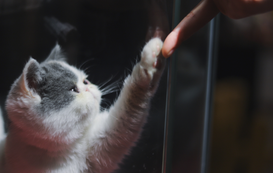- Home
- Cat Sitter Blog
- Cat Ownership
- How to Bathe Your Cat


Popular posts
How to Bathe Your Cat
How to Bathe Your Cat
Giving your cat a bath can be a daunting task. The fact is, most cats don’t like water, and they won’t hesitate to let you know it. If you’re not careful, the act of bathing them could end up looking like a war zone: a struggle back and forth, biting, scratching—fleeing for safety.
Thankfully, cats don’t need baths very often. Cats are self-grooming creatures that spend several hours a day licking their fur. This might not sound very hygienic to you, but it actually helps keep them both clean and stress-free. There are some cases where your cat does need a bath, though, and when that happens, it does not have to be a fear-inducing experience for either of you.
When is bathing your cat necessary?
As discussed, bathing your cat is not an activity you need to subject them to under normal circumstances; however, there are some cases where your cat’s tongue can’t get the job done. Here are a couple reasons when bathing your cat is actually necessary:
- Your cat gets something particularly dirty on their coat.
- You have a long-haired cat that needs extra grooming maintenance.
- Your cat has fleas, ticks, lice, or other pests under their fur.
- Your cat is elderly, obese, or arthritic.
If any of these situations apply, you’re going to need to learn how to give your cat a bath. Fortunately, you’ve come to the right place. Follow the methods below to make sure your cat’s bath is as safe and comfortable as possible.
Part 1: Prep
It’s important to make sure you’re fully prepared before you start bathing your cat. Unless you have the rare cat who actually likes hanging out in water, you’re going to want to make sure everything is in place ahead of time so that you can give your nervous kitty your full attention. Here are the supplies you’ll need ready on hand before you give your cat a bath:
- Gloves: using gloves will both keep you clean and help protect you against scratches and/or bites—just make sure they’re long enough.
- Cat shampoo: special cat shampoo is a must. It’s important that you don’t use human shampoo in order to avoid drying out their skin. Depending on the circumstance, it may be a good idea to get your vet’s recommendation on which one to buy. You can find shampoo for cats at any pet store or online.
- A washcloth: this is only needed if their face needs to be cleaned too.
- A bucket or pitcher of water: using a pitcher or bucket is necessary to avoid putting your cat near running water, which may cause extra anxiety for them. Depending on how large your cat is, fill a large bucket or 1-2 pitchers with luke-warm water. It’s important to make sure the water is at a comfortable temperature.
- A rubber mat: place a rubber mat in your bathtub or sink pre-bath so that your cat doesn’t slip.
- Towels: make sure to have a towel ready so you can dry off your cat post-bath. If you don’t have a rubber mat, you can put a towel at the base of your sink or bathtub as an alternative method to keep your cat from slipping.
- Treats: after the bath, be sure to reward and comfort your stressed kitty with treats. This way, they’ll be less likely to throw you a barrage of dirty looks in the coming days.
Before bathing your cat, consider trimming the tip of their claws for added protection against scratches. Furthermore, if you can, avoid giving your furball a bath when they’re acting particularly spunky. It will save you a lot of hassle to plan their bath when they’re relaxed or sleepy.
Part 2: Bathtime
Ladies and gents, it’s bathtime. Don’t stress: as long as you have your supplies prepared and are gentle with your cat, you can pull this off. Follow below for a step-by-step guide to make sure bathtime goes smoothly for you and your feline friend.
Steps:
1. With your gloves on and filled bucket or pitcher(s) ready, place your cat into a large sink or bathtub.
2. Next, let your cat get acquainted with the water. This will help them understand it won’t hurt them.
- Allow them to sniff the area and investigate your water pitcher(s).
- Put some water on your fingers and let them sniff it, then place your wet hands lightly on their fur. Repeat the process a few times.
3. Once your cat has been introduced to the water, hold them carefully, and begin scooping water over their body from the neck down. Be sure to avoid their head for now.
4. When they’re sufficiently wet, massage the special cat shampoo into their fur.
5. Pour the remainder of the pitcher(s) over their fur from the neck down, making sure to rinse out all the shampoo.
6. Now, dampen your washcloth and carefully wipe their cheeks and forehead, avoiding their eyes and ears. You don’t need to use (diluted) shampoo unless their face is particularly dirty.
7. Towel-dry as much water off your cat as you can, and then let them air-dry in a warm room, so they don’t get too chilly.
8. Now it’s time to give your cat a lot of love and treats to reward them for a successful bath.
It’s likely that most cats will never view the bath experience as a particularly fun time, but these tips will greatly reduce bath-related stress. Keep in mind, there are some cats that might still find the experience too distressing. Make sure to be very gentle during the bathing process and stay attuned to how your cat is handling it. If it’s just too much for your little guy, it may be necessary to use a professional grooming service. In some cities, you can hire a mobile grooming service that will come right to your house. Or, if your cat isn’t too dirty and isn’t dealing with bugs, you can use cat cleaning wipes to take the “scary” water out of bathing.




































































